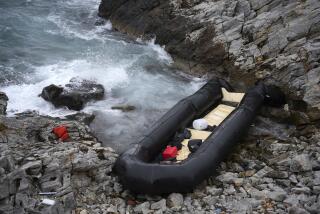Hundreds of migrants attempt to swim from Morocco to the Spanish territory of Ceuta

- Share via
BARCELONA, Spain — Thousands of migrants have attempted to cross the border from Morocco to the Spanish exclave of Ceuta in the last few days, including hundreds of youths who tried to swim their way around controls, Spanish authorities said Monday.
Videos broadcast on Spanish media over the weekend showed Spanish police intercepting migrants in the water at night amid a thick fog but also in broad daylight, struggling to separate the new arrivals from crowds of beachgoers.
Cristina Pérez, the Spanish government’s representative in Ceuta, told journalists Monday that since Aug. 22 an average of 700 people had attempted to breach the border daily, with a peak of 1,500 attempts Sunday.
Pérez did not disclose how many had successfully reached Ceuta but Pérez explained that following Spanish law that allowed for “border rejections” authorities were sending back to Morocco between 150 and 200 people a day. She thanked Moroccan authorities for their “loyal cooperation.”
Ceuta and Melilla — two tiny Spanish territories in North Africa bordering the Mediterranean — have long been targeted by migrants and refugees seeking better lives in Europe. Many attempt to climb over barbed wire fences encircling the autonomous cities or reaching the exclaves by sea.
Most of the 32,000 migrants who have made the treacherous boat journey on the Atlantic Ocean to Spain’s Canary Islands this year arrive from Senegal.
Due to geography, Spain relies largely on Morocco’s goodwill to control those borders and keep migrants out. In 2021, after a diplomatic spat between the two nations, thousands of people, including many unaccompanied Moroccan children, poured into Ceuta in a matter of days, overwhelming Spanish authorities.
Spain and Morocco have since normalized their relations and have been working together to tackle irregular migration, but authorities in Ceuta say they are again under pressure this year. There have been 1,622 migrant arrivals to Ceuta from January to mid-August compared with just 620 in the same period last year, according to statistics released by the Spanish Interior Ministry.
In February, residents of the nearby Moroccan town of Belyounech attempted to swim to Ceuta after the Moroccan government began demolishing unauthorized beachside homes to make way for new development.
Although the number of migrants to reach Ceuta represents just a tiny fraction of the more than 31,000 irregular arrivals to Spain this year, Pérez said the 7.14-square-mile territory was under “extreme migratory pressure.”
Brito writes for the Associated Press.
More to Read
Sign up for Essential California
The most important California stories and recommendations in your inbox every morning.
You may occasionally receive promotional content from the Los Angeles Times.














